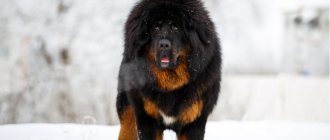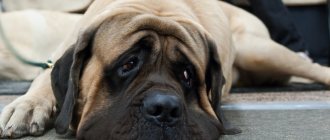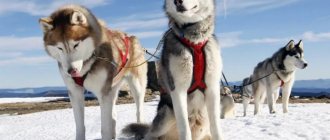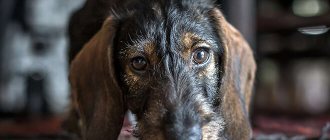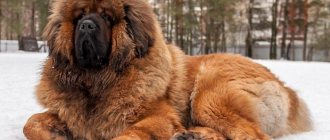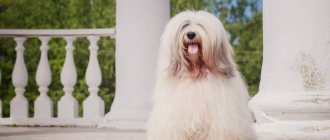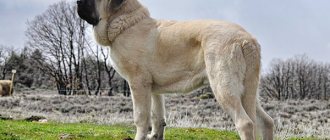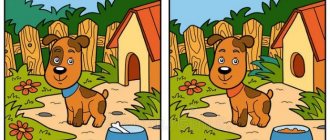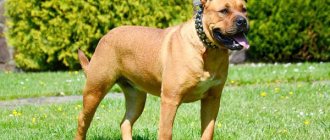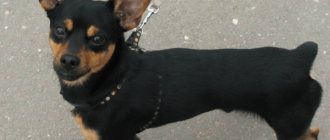The Tibetan Mastiff is one of the largest dogs in the world. A very calm, alert and balanced dog. He will be an excellent watchman and a loyal family friend.
The article contains a complete description of the breed, character traits, nuances of keeping and caring for such a large dog. At the end there are prices for puppies and a list of kennels where you can buy a puppy.
More photos →
| How long do they live? | 10-12 years |
| Weight | 64-78 kg |
| Height (height at withers): | males from 66 cm, females from 61 cm |
| Puppy price | starts from 50 thousand rubles and above depending on the breeder, class, title of parents |
Origin of the breed
They say that Marco Polo and Aristotle mentioned the ancestors of Tibetan mastiffs in their notes. They also say that they were used to guard monasteries in Tibet, and the red spots above their eyes were considered a sacred second pair of eyes, with the help of which unclean spirits can be seen. And that the first pair of mastiffs were kept in the zoo like wild animals, they were so huge and formidable.
And some dog lovers believe that it was the Tibetan mastiff that became the legendary ancestor from which all Molossians came: Rottweilers, Boxers, Mountain Dogs.
But all these are unconfirmed rumors.
It is known for certain that the first Tibetan came to the West in 1847, when a certain Lord Harding sent him as a gift to Queen Victoria. And that the first officially registered litter was obtained in Berlin, in 1898.
The breed standard was registered a little later: in 1904. The current one was revised and adopted in 2004.
Tibetan mastiff next to a man
Attitude towards the owner and other family members
The character of the Tibetan Mastiff is complex; the dog also contains tenderness, love and stubbornness, self-confidence, the desire to protect and a number of other traits.
Quite independent animals still need communication with their owner and love affection. Representatives of the breed have the ability to sense the mood of the owner.
Tibetan mastiffs, understanding by nature, treat children well, patiently enduring their tricks, with a degree of caution, realizing that children are defenseless and weak creatures who need to be treated condescendingly. However, you should not leave the Tibetan Mastiff alone with children, especially if some of them are not your own (for example, neighbors). Children tend to play loudly, run, fight, sometimes cry over trifles, to which the dog can immediately react and come to the defense of the owner’s children, thinking that the child is in danger or harmed. If children are too intrusive, provoke the animal, or tease, then children run the risk of being bitten. Therefore, it should be remembered that although a dog is affectionate with children, it is still not suitable for the role of a nanny. Children should be explained that the dog must be treated with respect, keep a distance, and not interfere again in the pet’s space. An animal can intervene if it sees spouses quarreling or loud discussions between adults.
At a young age, animals are active, love to run and willingly play with their owner, but with age they become less mobile, more serious, and more clearly display the qualities of a guard. Sedentary, deprived of active walks and physical activity, excessive attention from the owner, Tibetan mastiffs adapt to this lifestyle and can spend time lying at the feet of the owner.
Description of the breed
One Tibetan weighs as much as 25 baby Chihuahuas. If a person sits next to him sitting on the floor, he will turn out to be as tall as him or even a little shorter. And if he stands up, he can put his paws on the shoulders of the standing person and touch his nose with his nose.
Such visual examples allow you to imagine how big this dog is. According to the dry numbers of the standard (FCI-Standard N°230), this is more difficult to do, although they are more accurate.
- The height of males starts from 66 cm. The height of females starts from 61. The weight is on average 60 kg, but it can be more in large, muscular representatives who move a lot, run a lot and eat a lot of protein foods. Sexual dimorphism is very pronounced, especially for canines: females are noticeably smaller and lighter than males.
- The skull is slightly larger than it would be in proportion, slightly rounded, the muzzle is square in shape.
- The lips fit tightly to the jaws along the entire length, but folds are acceptable at the corners, especially in adults and elderly individuals.
- The jaws are strong and have a scissor bite in which the upper incisors overlap the lower incisors. Let's assume a straight bite.
- The eyes are oval, medium in size, slightly inclined in relation to the muzzle. The eyelids fit tightly, the look is serious, inquisitive. The color is always brown, the darker the better. Even in light colors, light eyes are not allowed.
- The nose is black, even in light colors.
- The ears are triangular, medium in size, hanging. If the animal is excited, they rise. Covered with short soft fur.
- The neck is strong, muscular, folds are allowed, but in small quantities.
- The body is rectangular, slightly longer than the height at the withers. The back is straight, the croup is wide and flat, the chest is deep, moderately wide, the ribs are compressed, reaching to the elbows.
- The legs are muscular, straight, set parallel. The hand has soft, thick hair.
- The tail is medium-sized, in a calm state it is held at the level of the back, in an excited state it is thrown over the back when running. Abundantly covered with long hair.
The movements are light, strong, the dog jumps without tension, is able to jog for several hours and not even get out of breath. When it accelerates, it runs “track after track”, placing its paws in one line.
Estrus is only once a year, two or three puppies are born. They mature very late - in this regard, they are perhaps the slowest developing breed. Bitches are considered mature at 3 years of age. Males become fully grown only at 4.
For comparison, a baby Yorkie is considered fully formed at six months.
Tibetans live on average 12 years, which is a lot for such a large dog.
Inconsistency with the standard, for example, a tightly curled tail, large ears, a wrinkled muzzle, light eyes, a light nose, leads to a decrease in points at shows. A dog with shortcomings will not see the title of champion, so breeders will sell it as a pet class, cheaper than others. Security qualities and intelligence, however, are often preserved even in dogs that do not fully meet the standards.
There are a number of flaws that are not allowed even in the pet class: aggression or cowardice, severely distorted bite, strong deviations from the standard, incorrect coloring.
Colors
The coat is thick and hard, the undercoat is dense, the outer coat is of medium length. The tail is very bushy, as are the hind legs. There is a dense collar around the neck, similar to a lion's mane - it is denser in males, less so in females, but it is also present. Surely this was done so that the dog would not get hurt in a fight with predators who were aiming for the throat.
The following colors are allowed:
- rich black;
black tibetan mastiff - blue - that is, gray;
blue tibetan mastiff - gold - that is, red of different saturations;
Golden Tibetan Mastiff - sable - that is, red with a beautiful black pattern.
sable color
The standard allows tan markings on the face, paws and tip of the tail for all colors, but the purer the color, the greater the chance that the dog will be a champion. White spots on the chest and paws are also allowed, as well as beautiful symmetrical markings around the eyes.
White, beige, cream, brown, striped, and motley are not allowed for competition or breeding.
Features of the breed: character and behavior
The Tibetan Mastiff is characterized by good health. Under favorable conditions, adult dogs may not get sick. It is better to keep the breed outdoors using an enclosure. It is suitable for owners living in country houses with a plot. An urban environment is less suitable for an animal: the breed requires long walks and fresh air. It will take a lot of effort to raise a pet in the city.
The main advantage for dog owners is the absence of odor. The Tibetan Mastiff does not have the characteristic odor of these animals due to its love of cleanliness.
Thanks to its thick coat and strong immunity, the pet is suitable for living in the harsh northern climate. Sub-zero temperatures will not harm: the breed can sleep peacefully in the snow and survive in the cold for more than a day.
Often become energetic at night. They may suddenly vocalize at night, interfering with sleep. It will not be possible to wean an animal from this trait, since the dog’s lifestyle has been developed over many years.
In general, the Tibetan Mastiff is a calm and balanced animal. They have a willful and independent character. They are reserved themselves and are friendly towards other animals. Thanks to their watchdog habits, they treat strangers with suspicion and behave withdrawn.
An adult dog will not disturb the owner due to its unobtrusive nature. However, he willingly meets affection halfway.
Mastiffs are distinguished by their smooth, thick coat and dense undercoat. They are among the largest dogs: height from 65 cm, and weight does not reach more than 80 kg. They have a massive and heavy head, with a clearly visible bump on the back of the head and the transition from the muzzle to the forehead. They have strong jaws with a full set of teeth. The animal's muscles are well developed: a strong neck, body and limbs. The “lion’s” mane protects the dog’s neck and shoulders. The coat of a purebred pet should not be wavy; the coat should be soft to the touch.
Character
The Tibetan mastiff has a complex character, taken from its watchman ancestors, who were required to be able not only to notice a stranger in time, but also to decide what to do, and quickly: wake up the owners or catch the intruder himself before he runs away.
The result is a calm, balanced dog that has its own opinion about the world around it. Ready to stubbornly defend this opinion if someone disagrees with it.
In addition, it has retained its specific features.
1. territoriality. A watchdog defines its territory and protects it from any intrusion: this is instinct. Wherever the mastiff lives, in an enclosure, in the courtyard of a private house, in an apartment, he will do the same. And anyone who enters the territory will become the object of close observation, and if you do not take care of upbringing in time, then aggression.
2. permissibility of aggression. If someone tries to enter the entrusted territory, but the owner is not nearby, for a guard breed this clearly means that this someone is an intruder. The instinctive behavior will be the following: growl and bark to drive the stranger into a corner and wait until “their” people come. Attempts to escape should be stopped, if necessary, physically. If the owner is attacked in the presence of a Tibetan - or he decides that it was an attack, mistaking it for a playful fight, for example - the reaction will be immediate: drive away the attacker, if necessary, physically pull him away or even bite him.
3. devotion to one’s own and distrust of strangers. Even a well-socialized pet will never become the life of the party. He will love his owner, family and friends, “his” children and pets, but will consider all strangers as potential offenders. Accustoming an adult mastiff to a new person will take patience and time.
4. thirst for movement. It is not recommended to have a Tibetan in an apartment, unless the owner is willing to spend four to five hours a day with him in the nearest park. It is believed that this is a street dog, which is more suited to life in an enclosure. In fact, it is simply mobile, and the amount of effort that is required to keep the mastiff happy in the city is very great.
5. thirst for useful activities. Even though the Tibetan is increasingly seen as a companion dog, it was still bred as a working dog. If you spend your whole life walking with him along the nearby streets, and the rest of the time you let him doze off on the sofa, he will be bored and unhappy. We need some meaningful, interesting activity.
Secure the area. Follow the owner everywhere and protect him. Carry bags. Engage in active sports (for example, running with a person, fetching objects, walking over, over and inside obstacles), dancing. Even when looking after children, the main thing is not to leave your pet alone with very young children, since its size and weight are very impressive.
The Tibetan is a great option for those who need a working dog. He is calm, self-confident, balanced, gets along well with other animals and children, and is able to help with housework and entertain his owners. An excellent assistant and companion, selflessly devoted to his people.
Purpose and character of the Tibetan mastiff
The Tibetan Mastiff is originally a guard dog breed that gives voice only at the right time. Rarely will a mastiff bark without a good reason. Impressive size causes fear, and a dull and low voice causes fear.
There is no need to specifically train the Tibetan mastiff to protect the territory; the sense of ownership is developed at the genetic level. The dog will guard its habitat in any case. It is better not to keep him on a leash , so that a representative of this breed has the opportunity to run around his property, choosing a convenient vantage point.
Despite its solid appearance and impressive size, the breed is considered one of the friendliest . At the same time, the Tibetan mastiff clearly determines where “friends” are and where “strangers” are. It almost always protects the members of its pack, be it an adult, a child or another animal. However, there are very few recorded cases of dogs attacking their owners.
The adult is quite restrained in showing emotions, but willingly plays with children , even when she is already old (9-11 years old). Puppies are nimble, curious, playful, and after a year they become calmer and less active.
Features of training and education
In order for a Tibetan to grow into that same balanced, self-confident creature that the breed standard promises, you need to make an effort. If you don't take care of your puppy, he will grow up to be aggressive, stubborn and will make his own rules in the house. Given its size, it would be a real disaster.
Several qualities need adjustment.
The first is suspicion. Of course, it won't go away completely. But it is possible to arrange everything so that the puppy calmly accepts everyone whom the owner designates as “his own.” To do this, from a very young age, the puppy is introduced to new people and other animals. To begin with, with friends and relatives:
- The door opens, a friend enters the hallway, the owner at this time holds the puppy on a leash. If he sits calmly, doesn’t growl, doesn’t run to sniff, doesn’t bark, they pet him and give him a treat. If he growls or barks, they pull the leash, giving the command “ours” and reward the silent and calmed puppy with a tasty treat. And only then are they allowed to come up and meet you, with the permission of the owner.
- Then they do the same with people on the street (you can negotiate with dog walkers in the area). They see each other and begin to get closer. If the puppy is calm, reward him. If not, they try to get him to calm down and encourage him.
The command “our own” allows you to further restrain with one word even an adult Tibetan who intends to defend his territory from invasion. It is very convenient and allows you to avoid frightened guests, torn pants and other unpleasant consequences.
The second is aggression. Specialists work with it, since at home few owners have a friend to play the role of attacker, and few owners can do everything right right away. The training is called “protective guard service course.” During the course, the dog is taught to distinguish between attack and play, to listen to the owner in any situation and to knock the attacker to the ground rather than bite.
Otherwise, training a Tibetan is no different from training any large dog, which, if desired, is capable of knocking down or dragging a person on a leash along with it.
A six-month-old puppy, who will soon begin to show the first signs of adolescence, should already follow the following commands:
- "To me!". Mandatory, because it allows you to keep the dog from doing stupid and dangerous things. For example, from trying to run across a busy street or playing with another animal that is in a panic at such a prospect.
- "Ugh!". It’s also necessary, because it allows you to stop any unwanted action, from trying to climb onto the table and steal a piece of loaf, to trying to eat something obviously poisonous on the street.
- "Near". A well-mannered puppy does not pull on the leash and always walks at the owner’s left foot, without rushing forward. It is especially important because a six-month-old Tibetan who pulls on a leash is quite capable of dragging his owner along even against his will. And he will only continue to gain weight.
Other commands, such as “place”, “sit”, “lie down”, “run”, “fetch” and the like, are also learned, but rather for brain training and obedience. “To me”, “fu” and “next” are a mandatory set, without which it is impossible to cope with a Tibetan.
If the ward does not obey, is stubborn, shows aggression towards the owner, you should not shout or hit him - this stubbornness and aggression will only increase. It’s worth thinking about what’s wrong with the learning process and contacting a dog trainer, who will point out the mistakes and show how to correct them. The main thing is to do this before the puppy is completely convinced that he is right.
Inexperienced owners are better off going to a dog handler right away. Too serious a beast to risk making a mistake.
Training and education of the Tibetan mastiff
Tibetan mastiffs are quite easy to train because they have a good-natured and easy-going disposition, a sharp and good memory.
Elementary commands: “sit”, “lie down”, “place” can be taught to a pet as early as six months old. But the “voice” command will be unnecessary, since Tibetan mastiffs rarely bark unless absolutely necessary (a threat to the owner or territory). The pet must be rewarded for every command completed.
How to care
To keep your dog healthy and happy, he will need standard canine care.
First of all - combing. The animal is large, has a lot of wool, and sheds every year for two weeks in spring and autumn. You need to comb it first with a slicker brush, then with a regular comb, then with a massage brush. The resulting fluff makes excellent thread, and scarves and sweaters made from dog hair are popular.
A big plus for Tibetans is that they do not smell like dogs and their fur is designed in such a way that it hardly gets tangled.
It is not recommended to cut them; you can disrupt the hair structure and end up with a dog with split ends or problems with thermoregulation.
The remaining procedures are not so labor-intensive:
- Bathing. Any animal gets dirty on the street, this is normal. If the dirt is small, simply wipe it off with a wet cloth. If the dog gets all dirty, he is either driven into the bathtub or sprayed with dry shampoo and combed out. The procedure cannot be carried out too often, otherwise the production of fatty secretions will be disrupted.
- Nail trimming. Every two weeks they are cut with a sharp nail clipper of a suitable size, and then polished with a nail file.
- Dental treatment. They are cleaned every two days with a soft brush.
- Ear cleaning. The ears are drooping, so they are examined carefully every two days. If the ear is pink and clean, everything is fine. If dirt has accumulated in it, wipe it off with a cotton pad or napkin. If an unpleasant odor, swelling or fluid appears, the animal is taken to the veterinarian.
- Eyes. Despite their good shape, a little discharge still accumulates in them in the morning. They are washed with a damp cotton pad.
The pet is accustomed to all procedures while it is still very small. Considering the size of an adult dog, it will be impossible to force him or hold him against his will unless anesthesia is used.
And, of course, you will need daily walks. Four hours a day if the dog lives in an apartment, two or three if in an outdoor enclosure. Walk actively, play, run, communicate with other dog lovers. Harness it to a sled in winter, and harness it to a cart in summer.
Owner reviews of the Tibetan Mastiff
Sasha: Our pet not only became a family member and a faithful guard for us, but also a playmate for our children of different ages.
Yura: The breed is very easy to care for, but it requires a lot of space. They need to move a lot while walking, but they don’t pay any attention to other animals on the street, minding their own business exclusively.
How whimsical are your Tibetan Mastiffs? Is it possible to keep them in a city apartment without compromising their development? It is believed that dogs of this breed can easily become a “piece of furniture”, requiring absolutely nothing from the owner except some attention. But Tibetan mastiffs love long and productive walks: 1-2 hours in a park or square, adjusting to the owner’s step. Share with us your experience and knowledge about this wonderful breed.
Share
Leave a review
Diseases
Like most workers, the Tibetan Mastiff breed is considered healthy and strong, having taken the best from its ancestors. Even long generations of selection did not spoil the gene pool, introducing only three hereditary diseases:
- Dysplasia of joints, elbows and hips. Often found in large breeds with strong bones. Expressed in sudden degradation of the joints. Prevention of the disease is to prevent a small puppy from running a lot and jumping from high places. However, this does not provide a guarantee and often babies who are found to have a tendency to dysplasia are removed from breeding.
- Hyperthyroidism. Increased secretion of thyroid hormones. Disturbed hormonal levels lead to problems with hair, bones, appetite and character. The animal becomes nervous, aggressive, and does not obey commands. Prevention of the disease is proper nutrition and annual testing by a veterinarian. It is treated by constant use of medications that inhibit the production of hormones.
- Lymphocentral thyroiditis. This is also a disease of the thyroid gland, in which an inflammatory process occurs inside it - the tissues seem to reject themselves. It can be treated, but it is long and painful.
In addition to hereditary problems, mastiffs are prone to large breed problems. Due to poor nutrition, rickets develops - bones become thinner and brittle, and immunity decreases. Due to excess calcium, growths appear on the bones, and due to excess weight, joint diseases.
The best prevention is proper nutrition and a healthy dose of activity.
Brief characteristics of the Tibetan Mastiff dog breed
- Other possible dog names: Tibetan Mastiff, Tibetan Great Dane, Tsang-hi, Do-hi, Tibetan Mastiff, Tsang-Khyi, Do-Khyi, Tibetdoge, Tibetan Dog.
- Height of an adult dog: female – not less than 61 cm, male – not less than 66 cm.
- Weight: female – 55 kg, male – 65 kg.
- Characteristic color: predominantly dark (black) with red markings, brown, golden, red. A white star on the chest is allowed. A gray coat with red or light brown markings is the norm.
- Coat length: quite long, and the undercoat is thick and fluffy in winter. The coat is hard, straight, thin.
- Life expectancy: 14 years.
- Advantages of the breed: highly developed protective and watchdog instincts, inherent at the genetic level.
- Difficulties of the breed: Difficulties can arise as the puppy grows up if it is not trained and trained. It may be difficult to keep in a city apartment due to the size of an adult dog.
- How much does a Tibetan Mastiff cost: the average price for a puppy is 3000-4000 dollars.
How to feed
For a Tibetan to feel good and develop properly, he needs properly selected food. Dry food veterinarians usually recommend the following:
- Brit. Premium or super premium. Produced in the Czech Republic, it is considered very good. It has options: without cereals, for allergy sufferers and for pets with special needs, sick, sterilized, old or young.
- Flatazor. Extremely super premium. Produced in France, it also has varieties for allergy sufferers and those with special needs.
- 1st Choice. Made in Canada. Has an excellent line for puppies.
- Acana. Also from Canada, they have a good line for animals with allergies.
- Royal Canin. French food.
All feeds are similar in composition, only the proportion of nutrients differs. They all have online delivery, in case they can’t be found in pet stores in the city. They are expensive, but they are strikingly different from cheap food, where the first item is cereals, the meat is ground bones, and the taste is provided by chemical additives.
Rating of super-premium food for dogs.
When buying new food, you should not immediately take a bag - you must first make sure that it is suitable for a particular animal and will not cause stomach upset.
But you can feed your pet natural food. Of course, you will have to try to make it meet your needs. The general scheme includes:
Lean meat - poultry, beef, veal, not raw, but boiled or scalded with boiling water. This also includes offal: lung, heart, ears. Do not give liver and kidneys.
- Boiled porridge, in low-fat meat broth. Rice and buckwheat are best. (see what porridges are allowed for dogs)
- Vegetables - carrots, pumpkin, cabbage, peppers, boiled and raw, in small quantities. Fruits - apples, a little.
- Fermented milk products - cottage cheese, kefir, fermented baked milk. (see can dogs have milk)
Meat is the protein from which muscles are built. Porridges are carbohydrates that provide energy. Vegetables and fruits provide fiber, which promotes good functioning of the gastrointestinal tract. Fermented milk products provide calcium, from which bones are built.
As fat, no more than a spoonful of vegetable oil is added to the porridge every day, and once a week the dog is given a boiled egg, but not more than one, otherwise the load on the pancreas will become too strong.
Do not give raw meat, bones, fried, spicy, or with spices. They do not give white bread, only sometimes crackers as a treat. They do not serve sweet, smoked or fatty foods.
Sometimes sea fish is added - a source of phosphorus. But little by little. (see what kind of fish can a dog eat)
The required amount of food is determined based on the dog’s weight: three percent of the total weight. So, if a puppy weighs 30 kg, then he should eat 900 g per day.
Sick dogs, puppies, pregnant bitches, lactating bitches and elderly dogs are given vitamin supplements in their diet, compiled by scientists just for this case.
Keeping and caring for the Tibetan Mastiff
It is better to keep a dog of such a powerful guard breed in a private house with adjacent territory. At the same time individuals do not require special care , since they initially have excellent health.
Due to the presence of thick, long hair, the breed needs to be combed a couple of times a week with a regular massage comb or a special brush; during the molting period, combing is carried out daily.
The Tibetan Mastiff loves long, long walks , but when keeping it in the local area in the private sector, it is enough just not to tie the dog so that it has the opportunity to jog on its own.
Price for Tibetan Mastiff puppies
Tibetans are a rare breed; there are only two dozen nurseries all over Russia where they are bred. Like all rare and large dogs, they cost accordingly. The price of a puppy starts from 50,000 and goes up to 200,000.
For 50,000 they sell a pet class with defects that do not allow participation in competitions and reproduction. For 200,000 there is a premium class, puppies of champions of Russia and other countries.
Metis, sick or without documents are sold very cheaply, but they often die early.
Tibetan mastiff kennels
In Moscow and Moscow region
- Grand BIS grandbis.com +7-915-377-22-74, +7-968-482-69-57
- Chentao Park chentaopark.ru +7-916-042-49-95
- Crystal Orchid tibet-mastiffs.ru +7-916-118-76-28
- Limar tibmastiff.com +7-985-923-71-14
- Almon Tibet tibetandog.ru +7-916-387-25-27, +7-916-700-11-97, +7-985-333-91-57
- Grinshik Tibetan-mastiff Moscow +7-925-514-67-95, +7-985-767-24-75
- Talisman of the East talisman-dog.ru +7-916-574-90-28
- Tibetan Leo tibetan-mastif.jimdo.com +7-977-687-43-00, +7-905-572-99-79
- My Mastif mastif.info +7-916-753-13-09, +7-925-555-24-55
- Pharaoh's Dream mechtafaraona.ru +7-903-100-67-88, +7-977-975-39-10, +7-900-900-43-26, +7-977-975-39-11
- Russian Devil tibetmastif.ru +7-916-667-78-79, +7-925-314-68-62
- Dong Cheng Xi Jiu dong-cheng.ru +7-915-147-25-96
- Hyperion hyperion-kennel.com +7-926-319-39-33
In St. Petersburg
- Angel of Tibet angeltibeta.ru +7-921-943-40-00, +7-921-931-31-66
Other cities
Nizhny Novgorod
- Heritage of Tibet tmnnov.ru +7-920-250-58-40
Novosibirsk region
- Pride of the owner tmastif.ru +7-953-876-31-00
Vladimir
- Balchinira tibet-mastif.com +7-961-256-0778, +7-961-256-0780
Ekaterinburg and Sverdlovsk region
- Mastif Way mastif.gulliverland.ru + 7-343-336-76-77, +7-902-272-82-09, +7-919-368-65-21
- Best Timas besttimas.ru +7-952-729-89-10, +7-929-222-39-22
- From the House of Lyamins tibetskiy-mastif.ru +7-912-207-86-57, +7-922-617-98-75
Volgograd
- Ksiya Dzhu tibetskiymastif.com +7-919-541-11-00, +7 902-363-91-94
Krasnodar
- Koskaylas koskaylas.com +7-999-638-25-89
Photo
A selection of selected photos uploaded using the hashtags #tibetanmastiff, #tibetanmastiffpuppy on Instagram.

